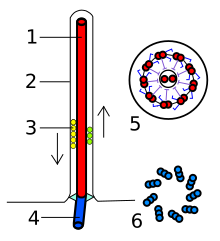Axonema

Axonema je svazek mikrotubulů uvnitř bičíků a řasinek eukaryotních organismů.[1] Obvykle se skládá z jednoho centrálního páru mikrotubulů a devíti dalších párů uspořádaných v kruhu kolem něho (9×2+2). Axonemy fungují primárně jako organizační centrum pohybu bičíku.[2]
- Průřez axonemou
Odkazy
Reference
- ↑ Stenesh, J. (1989): Dictionary of Biochemistry and Molecular Biology (2nd Edition). John Wiley & Sons.
- ↑ PORTER, Mary E., Winfield S. Sale. The 9 + 2 Axoneme Anchors Multiple Inner Arm Dyneins and a Network of Kinases and Phosphatases that Control Motility. J. Cell Biol.. 2000-11-20, roč. 151, čís. 5, s. 37F-42. Dostupné online [cit. 2008-09-14]. doi:10.1083/jcb.151.5.F37.
Externí odkazy
 Obrázky, zvuky či videa k tématu Axonema na Wikimedia Commons
Obrázky, zvuky či videa k tématu Axonema na Wikimedia Commons
Média použitá na této stránce
Transmission electron microscope image, showing an example of green algae (Chlorophyta).
Chlamydomonas reinhardtii is a unicellular flagellate used as a model system in molecular genetics work and flagellar motility studies.
This image is a thin x-section cut through the isolated axoneme. Chlamydomonas flagella have the "9+2" structure characteristic of all eukaryotic cells. The axoneme has a central unit containing two single microtubules and nine peripheral doublet microtubules (known as the "9+2"). Dynein sidearms project from the A tubule of each doublet. Also visible in this image are the radial spokes and the inner sheath.
Autor: Franciscosp2, Licence: CC BY-SA 3.0
Eukaryotic flagella. 1-axoneme, 2-cell membrane, 3-IFT (IntraFlagellar Transport), 4-Basal body, 5-Cross section of flagella, 6-Triplets of microtubules of basal body.


